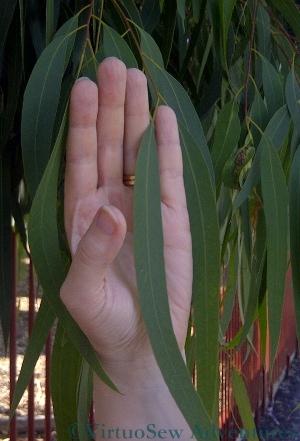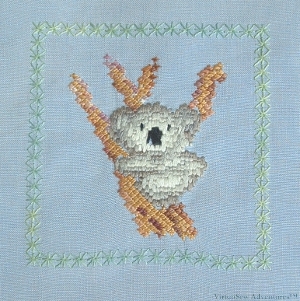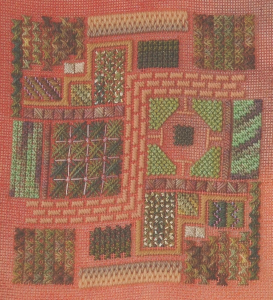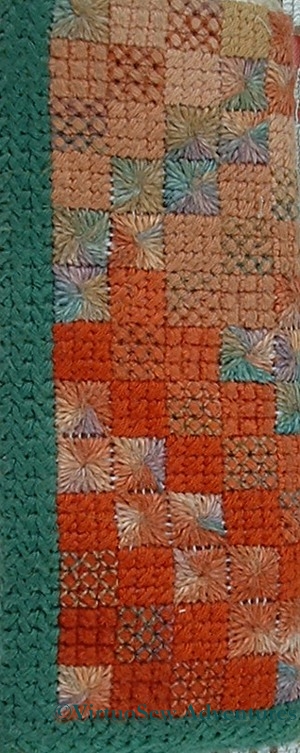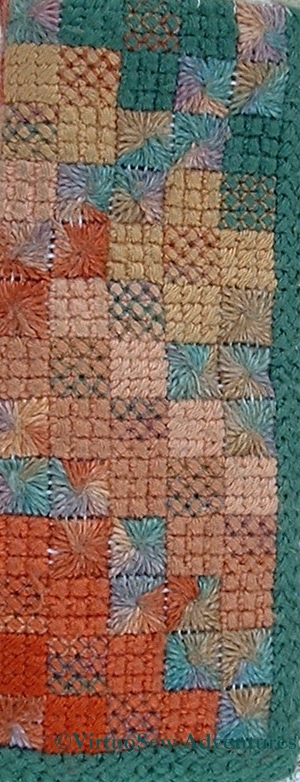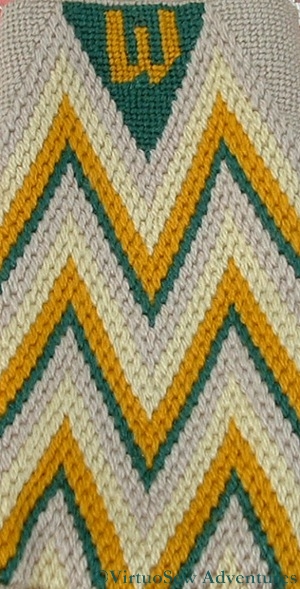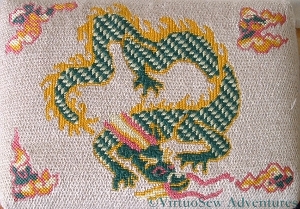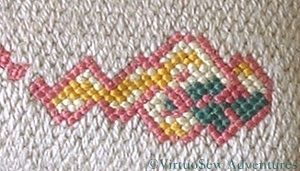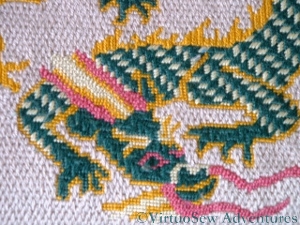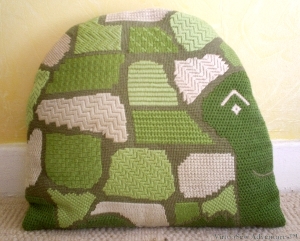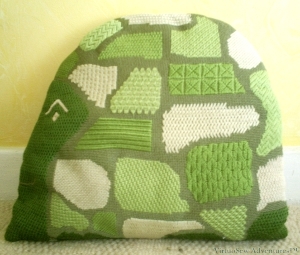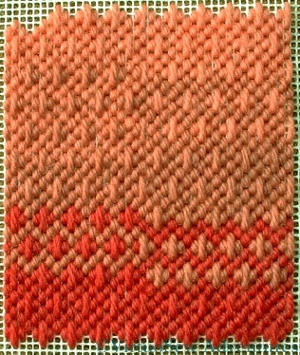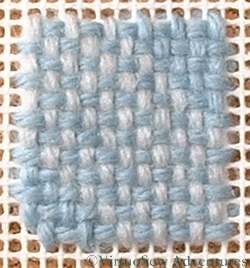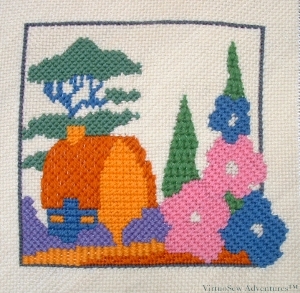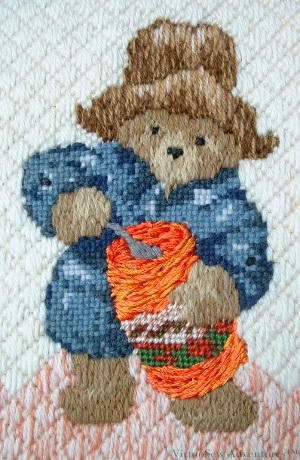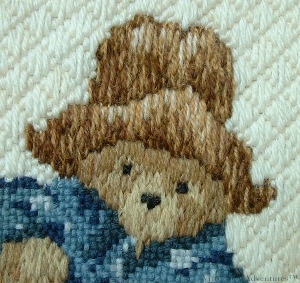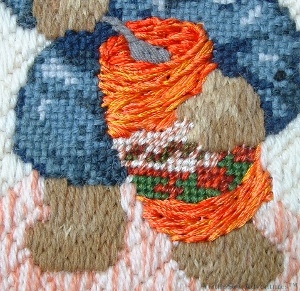Tag: canvaswork
Australian wildlife – backgrounds
One of the hallmarks of Australian Embroidery, as shown in the magazines, is a willingness to mix techniques and “play”. So while I have no idea of how I am going to show the Rosella, I’ve been thinking in terms of creating a background of tessellated Eucalyptus leaves, one way or another. There are several ways this could be achieved, which would be to some degree in the spirit of what I have read, and I still haven’t worked out which to use. Although I hate working samples, I may have to do so this time, as I haven’t the faintest idea whether they will work!
- For example, the simplest, once I’ve developed and charted a tessellation, would be to work the background on canvas, using complete coverage. That might be a little dull..
- Another possibility would be to use a painted canvas or to overlay the canvas with gauze, and then just work the leaf shapes themselves and leave everything else un-stitched. I like that idea, but I think it will need playing with, to get the right gauge of thread to provide suitable coverage and at the same time not puncture the gauze too obviously. I won’t be able to unpick it either, so stitching it might be a nervy business!
- Then there is the possibility of using waste canvas over a felt or a linen background fabric, so I can chart the tessellation without being stuck with canvas as the whole background.
- Finally – although this is well outside my usual range of stitching – I could create cut-outs of the leaf shapes and sandwich them between layers of gauze, with minimal stitching to hold them in place.
Gosh. When I sat down to write this, the last couple of ideas hadn’t come to me at all! That’s one of the unanticipated benefits of blogging, because in sitting down to explain what I am doing, or planning, I concentrate so much more on the subject that I get even more ideas, and what’s more, I’ve got them written down, so when I actually get to that part of the project, I have my notes – often illustrated notes! – to help me reconstruct my ideas.
It would be nice to work this while I’m actually in Australia, using Australian sourced materials, so I think I need to spend more some time planning the project before our next visit.
A Canvaswork Koala
In fact this is worked on linen, but using canvaswork stitches. I was playing with some needlepoint charting software, in particular to find out how the stitches appeared on the chart and how easy it was to follow. I can’t remember where the Koala came from, whether he was originally in counted cross stitch or whether he was imported from a drawing. It is quite a simple design with relatively little modelling, and I’ve always been rather fond of it.
I used waste canvas to give me the stitch placement, and then simply worked the design according to the chart. The Koala himself is worked in straight stitches using stranded cotton, all six strands separated and made to lie side by side; the tree branch he is clinging to is worked in two shades of pearl cotton, using upright cross stitch (one of my favourites, as you know by now!), and the green frame of Algerian Eye stitches is worked in one of the Wildflowers threads from Caron Collection.
The embroidery has survived much better than the fabric it was stitched on. Originally I made a cushion cover, but the linen was already old before I started and now has holes in it. I’m going to do something with the Koala (suggestions please!) and then the rest will probably go into a rag rug…
The Canvaswork Abstract Garden
Following on from the Knot Garden, I decided to play a little more with the idea of using the canvas as a background, rather than covering it entirely. Since I already knew the canvas would not be covered, I chose a piece of dyed canvas (from “Kate’s Kloths”, which I haven’t been able to find online).
The first element was the simple path in expanded brick stitch, worked in wool. The rest of the panel was then built up as a pattern of varying stitches and threads. There was no predetermined idea, simply the aim of keeping a sense of balance and rhythm in the pattern densities. You will notice that block sizes and shapes are repeated, reflected across the path which snakes across the centre.
I’m not particularly comfortable with abstract work or even with designing it, so this repetition and reflection of the blocks was a way to give myself a structure for the piece. Otherwise I find abstract work often feels rather chaotic and it doesn’t offer me the chance to puzzle out “a good stitch to represent such-and-such”, which is where a lot of the fun of the Persian Fantasy came from.
This was an interesting exercise, but like the Knot Garden, it has remained as a piece of canvas, not mounted, framed or incorporated into anything, because I really haven’t a clue what to do with it!
Another Canvaswork Sampler
Strictly speaking, this isn’t one of mine. My mother stitched this, but she asked me to design it for her after she saw the stripy sampler.
It uses the same principle of plain soft embroidery cotton and matching Wildflowers and Watercolours threads. This time, though, instead of straight stripes, the stripes were V-shaped.
It was rather more complicated and time-consuming, but it must have been a success because it is still in use and I had to sneak it from her handbag for the photograph!
It did teach me, however, that designs should be planned with their final use in mind. This looked much better as a flat panel than it does as a spectacle case!
Grandmama’s Dragon Footstool
I think that this was my first reasonably large canvaswork project, worked very early in my stitching career. The design was in the Readers Digest Encyclopedia of Needlework, which is a very good general introduction to a lot of styles of needlework, but needless to say, even at that early stage I made changes to both the design and the materials.
The Readers Digest suggested plain canvas – on the advice of my local needlepoint stop, I used interlock. The project pages said Tapestry wool – again, on advice, I used Persian Wool (lovely colours, and a really gorgeous sheen). They said Tent stitch – ah well, you can guess what’s coming, can’t you! Oh, and the colours were all changed, too. I did paint the design onto the canvas, using my mother’s oil paints, but after that, almost all resemblance to the project in the book ended.
The ornaments in the corners were worked in Upright Cross Stitch, which creates a surprisingly heavy texture for such a relatively simple stitch. Looking at the design now (after my grandparents died, the footstool came back to me) I rather feel that the original designer didn’t quite think things through. The corner motifs are all at different spacings from the dragon, and somehow the whole thing looks a bit congested. I think they may have designed for the round footstool bases that were popular at the time, and then added the corner motifs to make it more interesting for those who wanted a rectangular one. Nowadays, of course, I would try to have the courage of my convictions, and remove something or change the spacing, or alter the motifs to create a more pleasing effect. But a printed book looks so authoritative, doesn’t it – not for experimentation. One lives and learns!
The scales on the dragon’s body were worked in Oriental Stitch, and the spines on his back in Kelim Stitch, worked vertically instead of horizontally. Small details like eyebrows and outlining were worked in tent stitch (I do occasionally make the simple choice!). The trailing beard and horns were worked in rows of Knotted Stitch.
I don’t think I would use the same stitches again, or at least, not in all cases. I think the Oriental stitch is at the wrong scale for the dragon’s body – it was certainly a nightmare to get the compensation right! – and the beard and horns in fact need a heavier and more distinctive texture. The Kelim Stitch spines work well, I think, and the corner motifs in Upright cross stitch are successful too. I hadn’t, at this point, worked Slow-and-Steady, and although pictures of the worked stitches give you an idea of the worked appearance, it really isn’t the same as having done it yourself.
Still, it was fun, and interesting, and at the time, Grandmama said she was very impressed!
Slow-And-Steady in needlepoint
I worked this cushion from a design in one of the craft books Grandmama gave me (“The Book of Creative Crafts”, it was called, and it included woodwork, screenprinting and candlemaking as well as embroidery, needlepoint and rugmaking), but in my usual somewhat ambitious fashion, I did not restrict myself to a single side.
In some ways this made it easier, because the patches of stitching that represented the plates down the centreline of Slow-and-Steady’s shell had to be worked in the same stitch and colour on both sides. That at least meant that those decisions were only made once. I also decided that the shapes of the plates would be the same on both sides (approximately – they were drawn freehand!) and that the colour would be the same as well.
After that, I rummaged through every book on canvaswork I had, to find a sufficient variety of stitches to keep the work interesting. In effect it is a sampler, almost a practice piece, but camouflaged by making it irregular in shape and style. My favourite stitches pop up again – Leaf Stitch, Upright Cross Stitch, Linen Stitch, Byzantine Stitch. In fact this is probably where I met most of them for the first time.
I have a notebook in which I drew out the pattern and then listed all the stitches used, so that if I forgot how to work the stitch I would be able to look it up. I used Persian wool, rather than tapestry wool, and 14 gauge cotton single thread canvas. One thing I did not note down, and should have done, was how many strands of the wool I used for each stitch. I know they are not all the same, but I didn’t keep notes. That means that when I use these stitches in future, instead of checking on my previous experience, I will have to work samples all over again.
I did note down what the materials cost – £13.50. It was a very long time ago!
Calling him “Slow and Steady” was my idea. I always loved the Just-So Stories.
Follow Up to the Lady By The Lake
Several of the comments on my Lady By The Lake post asked me to show some close ups of how I achieved the colour changes on the skirt. I’ve not had enough light to get her down from the wall, so in the meantime I found a fragment of canvas and some tapestry wool and worked a couple of patches of stitching to show what I mean.
The stitch is a bordered Hungarian Stitch. I couldn’t find a diagram online, but I think it is fairly clear to see how the stitch fits together!
I was rather limited by the threads I had available, but I’ve tweaked the image in The Gimp, and I hope you can see that I’ve only used three colours of wool, but I’ve achieved seven variants of shade. In practice I think I would choose one or other of dark diamond and light border or light diamond and dark border, and stick with that choice, since changing between them is rather messy. That said, sometimes it’s worth the extra headache to get the precise effect you want. This stitch gave the Lady a slightly textured skirt with suitable shading without spending the earth on different thread colours.
As this patch shows, you can blend colours with Linen Stitch as well, and I have done in the past, when the available colours weren’t quite right for the effect I wanted to achieve. I didn’t do so on the Lady, because I wanted to create the effect of a glossy silk satin blouse. So rather than creating softer colours by blending them, I wanted strong shadows and bright colours. The Lady’s canvas was a double thread canvas, so I could choose to work at two different scales. I wanted to reserve the finest scale for her skin, so everything else used the basic canvas count, and the skin and features were worked as petit point.
Hmm, I really do need to get her down and try photographing her again, don’t I. There’s loads more to say about the Lady by the Lake!
More Canvaswork Inspired By Clarice Cliff
Emboldened by the combination of fun and applause (admittedly only from my parents at that point!), I moved on to the “Hollyhock House” design from the series of Designs Inspired by Clarice Cliff.
Again in two versions, and again I haven’t photographed the tent stitch cushion.
Hungarian Stitch is another of my favourites, and you will notice that there is still more Cashmere Stitch, Diagonal Mosaic Stitch and Upright Cross Stitch. I chose to work the poplar-like trees in a Sheaf Stitch variant, which I think was not hugely successful, but an interesting experiment. The background is Linen Stitch (diagrammed on my post about The Lady By the Lake) as it doesn’t obtrude, but it does cover the canvas thoroughly.
At some point soon I should find a suitable thread for the outlines and then finish these two. Then I can turn them into cushion panels or something and move on…
A Bear Called Paddington
I’ve always had rather a weakness for Paddington Bear, and this painted canvas caught my eye a few years ago, hanging up in a market stall in Leeds when we were visiting friends. Immediately I saw in my mind’s eye how almost every section could be worked, starting with using rayon thread for the jar of marmalade. In fact, as I recall, the part of this canvas that gave me the greatest difficulty was the choosing a stitch for the background!
Paddington’s duffle coat is worked in Linen Stitch using ordinary tapestry wool, and his fur is worked in Appletons wool using a sort of random, closely packed long and short stitch. Looking at this piece analytically for the first time since I worked it, I’m really quite pleased with how the Linen Stitch works for the dull woolly fabric of the coat, and how believable the fur has turned out to be.
I’m also very pleased with how different the hat looks. It too is worked in long and short stitch, but I used longer stitches and Paternayan Persian wool. The difference lies in thickness of the individual strands and the different level of sheen – Persian wool strands are rather thicker and have a lovely muted sheen, whereas the Appletons wool produces a slightly duller surface. The tapestry wool, of course, is almost completely matte.
Look at that little face! The only thing I missed is a smudge of marmalade on his nose..
Then there is the jar of marmalade that first caught my eye in the first place. I worked that using six strands of rayon, mixing orange, red, and yellow strands in the needle, and working rows of stem stitch around the jar. It looks much glossier and stickier in real life!
Finally, after much head-scratching and puzzling, I worked the background in a slightly enlarged version of Hungarian Stitch, using Persian wool. I blended a second colour into the base to give a sort of grounding section so that Paddington wouldn’t be suspended in mid-air. I can’t think why the designers didn’t do that, as when I was a child (I’m assuming this was really intended for children and not for grown-ups!) I would have been rather worried by the character not having any ground beneath their feet!

